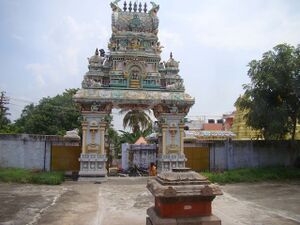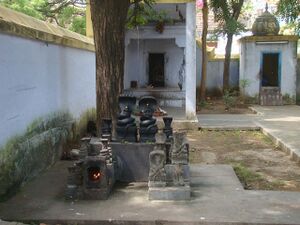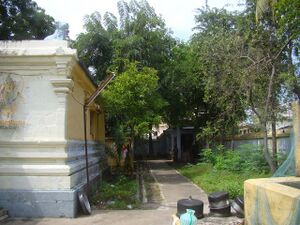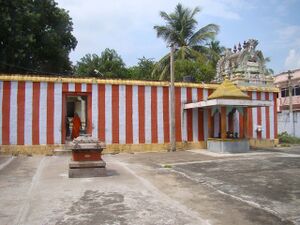Ozhuginasery Cholaraja Temple
Ozhuginasery Cholaraja Temple is a Shiva temple located in Ozhuginasery, Nagercoil. The main deity Choleeswaramudaiyar is depicted as a Lingam. Amman has a separate sanctum.
Location
Ulakamuzhuthudaiyal Sery, popularly known as Ozhuginasery, is a town that flanks the river Pazhaiyar, East of Nagercoil. In the etchings of bronze plates of Travancore kingdom, it is referred to as Ubamangalanery. Ozhuginasery Cholaraja Temple is located about one kilometer away from the Vadasery bus stand.
Main Deity
Shiva, the main deity of Ozhuginasery Cholaraja Temple is commonly known as Choleeswaramudaiyar. He is also known as Rajendra Choleeswaramudaiya Nayinar, Periya Nayinar and Rajendra Choleeswarar. In the epigraph he is mentioned as Aravuneer Sadaiyan and is depicted as a Linga on Avudai form in the sanctum. The linga in the sanctum sanctorum is three and a half feet tall. It is believed to be 18 feet tall underground. The spouse of the prime deity is Kolavaar Kuzhalaal Eswari or Kuzhaleswari.
Structure of the Temple
Ozhuginasery Cholaraja Temple faces the east. It is built based on Chola architectural style. Inside a walled compound are the sanctum sanctorum, Antarala[1], arthamandapam[2], a mandapa to clap and sing, Nandhi mandapam, muhamandapam[3] and shrines. Most of the structures in the temple were completed in the 13th century.
A Nandhi sculpture, in the mandapa outside sanctum sanctorum, faces the main deity. There is an inner enclave around the sanctorum. Amman shrine is set facing the main deity. In the outer enclave in the southwestern end Vinayagar shrine faces the east. The Naga sculptures are placed under a tree in the outer open space. There is a Murugan shrine at the North Western corner.
Ozhuginasery Cholaraja Temple resembles a miniature of the Pragadeeswarar temple of Tanjore. The temple tower is styled after the Pragadeeswarar temple. Similarly there are nandhi statues on the walls on four sides and the four corners of the roof.
Sthala Vriksha[4] are the Indian Bael (Vilvam) and the golden rain tree (Kontrai).
History
The history of the Ozhuginasery Cholaraja Temple is connected to the old name of Nagercoil that is Kottaru (Kottar). Based on where the temple is located it gains prominence in the history of southern Kanyakumari..
Cholaraja Temple was built in 1100 C.E. The construction was overseen by a Chola army officer Mazhavarayan. It was a place of worship even before the temple was built. An epigraph from 1140 C.E mentions that the Governor Vikrama Chola Pandiyapuram Bala Bharathan had installed the Vinayagar sculpture in the temple. An epigraph from 1252 C.E mentions the holy installation of Shrikuntram erintha Vinayagar. Until the 12th century, Tamil brahmins have performed the rites in the temple.
Kulothunga Chola the first, while in Kanchi, has provided financial support (Nibantham) to the temple. An epigraph from 1243 C.E mentions the financial support provided by Chalukiya King Vishnuvarthan. In 14th century C.E Pandiya kings have also donated to the temple. The temple owned considerable wealth and property.
Devadasi tradition was introduced here during this period. An inscription from 1243 C.E mentions an order that the Neivedyam[5] be first given to Devaradiyal Vadukan Gunavan’s sister Komalavalli. Sengodan Poovandi, a devadasi, had donated 20 gold coins to the Sivakami Amman in the temple
Thamizhan Manikam, the head of the army stationed here (1109 C.E) and Azhippan Thirumal of the 13th century had also made donations to the temple. The temple was administered by the head of the army stationed in Ozhuginasery.
References
- Thenkumari Kovilkl, Prof. A. K. Perumal, Sudarsan Booka, 2nd Edition 2018
- Photos Credits Raji
Footnotes
✅Finalised Page




